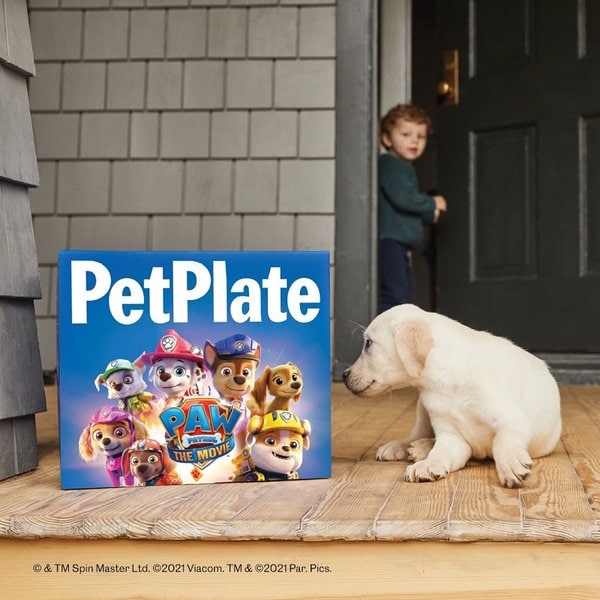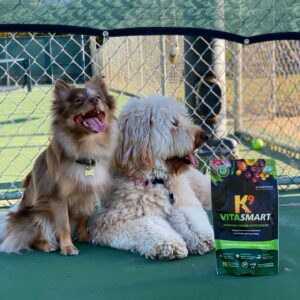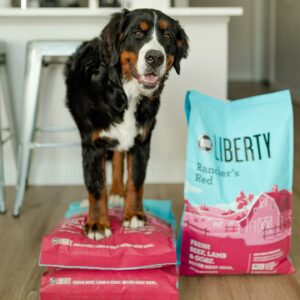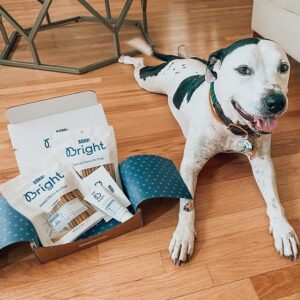The best dog food for Labradors is Purina Pro Plan Puppy Dry Dog Food.
Welcoming a new Labrador puppy into your family is an exciting time. It’s full of hard work, and comes with a steep learning curve, but ultimately a highly rewarding process.
One of the things that you might be considering – so what is the best puppy food for a Labrador puppy?
We did our research and have identified the nine best puppy food that you can feed your Lab puppy. Starting them off with the right nutrition will help them grow up to be strong, healthy adult Labradors.
What’s more? We have also included a handy’s buyers guide for you to make an informed decision too.
#1 Purina Pro Plan Puppy Dry Dog Food
We chose the Purina Pro Plan dry puppy dog food as our top pick. What we really liked about it is that it is specially formulated for large breed dogs like the Labrador Retriever puppy.
Large breed puppies need more nourishment and nutritional intake as compared to smaller breed puppies. With this purpose in mind, the Purina Pro Plan is formulated with DHA, antioxidants, calcium, and omega-6 fatty acids.
To meet the dietary requirements and lifestyle of a broader range of dogs – including Labrador Retrievers – Purina has developed five formulations: Savor, Focus, Sport, Bright Mind, and Nature. Each of the formulas is available for puppies as well, which is the thing that we are looking for today.
We wouldn’t choose puppy food as our top pick if it weren’t made from real ingredients. Each of the available flavors has meat as its primary ingredient, as well as omega-rich fish oils to help promote brain development and antioxidants to strengthen the immune system.
Its wide range of package sizes, flavors, and formulations should allow any Labrador owner to provide their pups with all the nutrients they need. Formulated with high-quality and real ingredients, Purina Pro Plan puppy food is the highly recommended choice for your growing Labrador pup.
Pros
- The high protein content of Purina’s Pro Plan dry food for puppies, which is guaranteed by the use of real chicken as the first and major ingredient, promotes proper growth and optimal physical development of Lab pups.
- The omega-6 fatty acids and vitamins contained in this Purina formula assist a puppy in developing and maintaining healthy skin and coat.
- The inclusion of glucosamine in this dry dog food product provides the nutrition that is needed to facilitate the development of healthy joints and cartilages in puppies.
- Additionally, this Purina recipe also contains calcium and phosphorus to aid in the formation of strong bones and teeth in Labrador puppies.
- The absence of artificial flavors, preservatives, and coloring in the Purina Pro Plan dog food makes this product safe to be consumed by puppies.
Cons
- The Purina Pro Plan puppy food has quality control issues, as several customers have reportedly received food bags that were littered with insects and larvae, thereby making the kibble unfit for consumption.
- Several puppies have reportedly developed diarrhea and vomiting after eating this Purina Pro Plan formula.
We vote this product to be our top pick because its formulation meets the nutritional demands of a growing large puppy breed and includes vital ingredients, such as glucosamine for developing joints, omega-6 fatty acids for healthy skin and coat, and real meat for high-quality proteins.
#2 Holistic Select Natural Dry Dog Food
This dog food’s basic recipe is similar to those found in Holistic Select’s other adult dog food. Moreover, this recipe includes chondroitin and glucosamine for joint support, which is essential for large or giant pups with pre-existing joint issues.
It also contains the amino acid L-carnitine. L-carnitine supplementation is thought to aid with any possible deficiency in giant dog breeds prone to poor heart conditions.
You may find that this product uses some carb-heavy ingredients, like oatmeal and rice. While this food contains a lot of carbohydrates, it is indicated for large-sized puppies with sensitive stomachs to consume.
This dry dog food from Holistic Select comes highly recommended for those who require a high-quality adult recipe that is designed to meet the long-term health demands of large canines. It’s an excellent food for puppies with sensitive tummies.
Pros
- This Holistic Select recipe contains omega-3 fatty acids to provide the nutrition essential for the maintenance of healthy skin and coat quality in puppies.
- This Holistic Select formula contains a healthy amount of natural dietary fibers that aid a puppy’s digestive system and ensures that the pooch doesn’t have issues digesting kibble.
- Holistic Select’s dry dog food is prepared without using meat by-products, fillers, wheat, wheat gluten, artificial flavors, coloring, and preservatives, ensuring that the kibble is safe for Lab puppies to eat.
- This natural dry dog food product contains a combination of antioxidants, probiotics, and taurine that work together to strengthen a puppy’s immune system and provide support for the pooch’s heart.
- This natural dry dog food formula for puppies is produced and packaged in the United States with ingredients gotten from reputable sources around the world to ensure adherence to safe manufacturing practices.
Cons
- Several customers have claimed that their puppies didn’t like the flavor of this Holistic Select formula and refused to eat the kibble as a result.
- Some puppies have reportedly become itchy after eating the Holistic Select dry dog food kibbles.
#3 Royal Canin Labrador Retriever Puppy Dry Dog Food
If your Labrador Retriever puppy is very picky about his food, then this Royal Canin breed-specific puppy food might be the right pick. After all, it is made for Labrador puppies specifically!
It’s specially formulated to meet the growing nutritional needs of Labrador puppies from 8 weeks to 15 months old. From our research, many Labrador puppies owners have complimented this product for giving their pup:
- Shiny and soft coat
- Fantastic energy levels
- Healthy monthly weight gain
It is also designed to promote better nutrient absorption. With donut-shaped kibbles, they help to slow down the rate of ingestion by promoting chewing, which in its turn can improve digestion. This is important as Labradors are prone to suffer from bloating.
Ultimately, this could mean noticeably improved bone and joint development, enhanced coat and skin health, and steady growth for puppies younger than 15 months.
We liked Royal Canin Labrador food for its focus on Labrador puppies. And this can really make a difference since Labradors have a unique muzzle length, jaw structure, and distinctive coats!.
Pros
- This dry dog food product is specifically formulated with a precise mineral content to meet the nutritional needs of Lab puppies aged between 8 weeks to 15 months old in a bid to promote optimal physical development.
- The donut-shaped kibble of this Royal Canin formula, which is prepared in accordance with a Lab’s face and jaw structure as well as bite patterns, helps slow down fast eaters and ensures that they chew kibble properly before swallowing.
- The antioxidant complex contained in this Royal Canin recipe fortifies a puppy’s immune system and improves the pooch’s ability to fight off diseases and infections.
- Royal Canin’s dry dog food product for Lab puppies contains prebiotics to facilitate the growth of healthy gut bacteria that are beneficial to a pooch’s digestive system.
- The calcium and phosphorus ingredients contained in this dry dog food promote the development and maintenance of strong bones and joints in Labrador puppies.
Cons
- There are doubts over the quality of the ingredients used in preparing Royal Canin’s puppy food because chicken meal is used as the main source of protein in the recipe, instead of real chicken.
- Several customers have commented that their pooches developed diarrhea and stinky stools after consuming the Royal Canin kibble for Lab puppies.
#4 Hill’s Science Diet Large Breed Dry Dog Food
If you’d like a wider variety of flavors for your Labrador Retriever puppy, then Hill’s Science Diet dry dog food may be a great pick for you.
In terms of flavors, this food product is similar to our top pick. However, it may be better in the sense that it doesn’t have various formulations for puppies: you won’t have to wrap your head around different form factors of dry food.
What’s much more important about this pack is that it delivers all the nutrients a Labrador puppy would need. Based on either chicken or lamb, this dry food pack includes glucosamine, chondroitin, amino acids, minerals, and vitamins.
Made with a balanced set of minerals and natural ingredients, Hill’s Science Diet puppy food will help to promote strong bones and teeth in your growing Labrador pup.
Pros
- This Hill’s Science dry dog food formula contains a blend of antioxidants and vitamins C and E that work to strengthen a puppy’s immune system and improve the pooch’s disease-fighting abilities.
- The controlled levels of calcium contained in this Hill’s Science recipe for large dog breeds provide support for optimal bone growth and development in Lab puppies.
- This dry dog food recipe is suitable for Lab puppies because it contains a generous amount of DHA from fish oil to ensure healthy brain development for a puppy.
- Similarly, this formula’s glucosamine and chondroitin content strengthen a puppy’s muscles and also fortify the connection between the pooch’s joints.
- The Hill’s Science dry dog food for large breeds is produced in the United States without artificial colors, flavors, and preservatives that may be detrimental to a puppy’s health.
Cons
- Consumption of the Hill’s Science diet has been linked to the production of large amounts of stool in some puppies.
- The appearances and sizes of this product vary greatly from bag to bag, thereby raising concerns over this product’s quality control processes.
#5 Diamond Naturals Dry Dog Food
Diamond Naturals dry dog food uses a lamb and rice formula designed for puppies who are fond of lamb meat. Since the proteins in this food are made from real pasture-raised lamb, it may be the best lamb meat dog food available out there.
Not only is the food in this pack flavorful, but it also is easy to digest, thanks to the small-size kibble. If your Labrador puppy has been having problems with larger kibbles, this one may be able to help you.
Diamond Naturals dog food comes in three bag sizes; 6 lbs, 20 lbs, and 40 lbs. These size options will provide sufficient flexibility to accommodate your grocery purchases or restocking schedule. The 40-lb pack is especially notable since it can last for a much longer period!
Each bag from Diamond Naturals is power-packed with essential fatty acids, antioxidants, and superfoods, such as kale and chia seeds, guaranteed to provide the fullest nutritional value you can get out of each serving. Its smallest size option comes in a 6-lb bag for convenient taste testing, if your pup is a picky eater.
Pros
- The precise protein content of this dry dog food, which is guaranteed by the use of real pasture-raised lamb as a major ingredient, provides optimal nutrition to support the physical needs of growing Labrador puppies.
- Diamond Naturals’ dry dog food contains vitamins and minerals – which are gotten from superfood ingredients such as blueberries and oranges – which provide the nutrient levels needed to ensure that puppies remain in good health.
- The omega fatty acids contained in this dry dog food recipe facilitate the development of healthy skin and coat in puppies.
- The proprietary probiotics contained in Diamond Naturals’ dry dog food ensure the seamless digestion of kibbles that are ingested by a puppy.
- This dry dog food recipe from Diamond Naturals contains L-carnitine, which helps to convert the protein and fat content of the kibble into energy needed for the physical development of a puppy.
Cons
- The inconsistencies in the appearance of the Diamond Naturals dry dog food often results in some pooches occasionally refusing to eat the product.
- A considerable number of puppies have developed gastrointestinal issues, such as diarrhea, after eating the Diamond Naturals kibble.
#6 IAMS Proactive Health Puppy Dry Dog Food
The key notable feature of IAMS Proactive Health puppy food pack is that it is available in 3 size options. This flexibility allows you to better manage the supplies of dog food stocked at home. Besides, the smallest 7-lb bag size would allow you to try out the food before considering incorporating it as a part of your dog’s diet.
Convenience is great, but what is more important is that this dry food packs 22 key nutrients to match the nutritional value found in a mother dog’s milk. Well, another reason why you and your Labrador puppy may favor this product is that it uses real, farm-raised chicken as its primary ingredient!
What we really liked is that this large breed puppy dog food from IAMS provides Lab owners with a lot of options for food supply management. It’s highly nutritious and flavorful.
Pros
- IAMS Proactive dry dog food is formulated with at least 22 key nutrients that provide all-around nutrition for the healthy growth of Lab puppies.
- The use of real, farm-raised chicken as the major source of this IAMS recipe’s animal protein ensures that puppies have access to the amino acids needed to form strong muscles.
- This dry dog food recipe is devoid of filler ingredients, artificial preservatives, and flavors to ensure that puppies gain optimal nutrition from the consumption of the kibble.
- The omega-3 DHA that is obtainable with IAMS’ dry dog food product facilitates the mental and cognitive development of Labrador puppies.
- IAMS Proactive dry dog food is available in three size options – 7 lbs, 15 lbs, and 30.6 lbs – which enables customers to make purchases based on their pooch’s eating habits and budget.
Cons
- A significant number of dogs have reportedly developed diarrhea after eating the IAMS Proactive dry food.
- Some customers have commented that the IAMS kibbles were too hard for their puppies to chew.
#7 Nulo Freestyle Dry Puppy Food
Nulo Freestyle dry puppy food is a complete and balanced formula for growing large breed puppies with adequate calcium and phosphorus ratios. This tasty grain-free salmon and turkey recipe will definitely have your dog begging for more.
This recipe contains 80% real meat proteins to help your furry friend grow large and strong. It also contains DHA fatty acids sourced from real salmon, which help to improve brain and eye development. Healthy calcium levels also help your doggie’s bones and teeth to stay strong.
Additionally, it contains BC30 Probiotic, which helps to enhance the immune system, improve metabolism, and ease digestion. It is essential for any pup’s health to have proper nutrition, and Nulo guarantees that your puppy has all it requires from the start.
Even though this puppy food recipe from Nulo Freestyle is a little on the pricey side, we believe it is worthwhile for the quality you can expect. The ingredients were all-natural to help your puppy maintain a healthy weight, a balanced diet, and a high level of energy. If you don’t want to make your own food for your beloved pooch, this purchase would certainly help.
Pros
- The real salmon ingredient used to produce Nulo Freestyle’s puppy food provides DHA, which plays a vital role in the development of a puppy’s central nervous system.
- The grain-free recipe of the Nulo Freestyle puppy food, which is devoid of corn, wheat, and soy, makes this product ideal for consumption by pooches with food sensitivities and grain allergies.
- This dry dog food product contains patented BC30 probiotics that improve a Lab puppy’s gut health, ensuring that pooches don’t encounter serious issues with the digestion of kibble.
- This dry puppy food is manufactured in facilities located in the United States to ensure that the produced kibbles are safe and fit for canine consumption.
- The high animal-based protein content of this dry puppy food product provides the amino acids that are needed to fuel healthy muscle development in Labrador puppies.
Cons
- Some pooches have developed bad breath after feeding on this dry dog food from the Nulo brand.
- Several customers have also bemoaned the high price point of the Nulo Freestyle dry puppy food.
#8 Eukanuba Puppy Dry Dog Food
Formulated with various ingredients like natural fibers and high-quality chicken proteins, among everything else, Eukanuba dry dog food is designed to promote healthy digestion and nutrient absorption.
With its large breed formulation containing DHA, calcium, and phosphorous, it helps to support essential brain function, healthy muscle growth, and bone health during the early stages of your pup’s development. Available in a 33-lb bag size, this product will definitely last for months.
Overall, a well-rounded large breed puppy food that contains all the essential ingredients needed for your Lab puppy’s development. Comes with a feeding table for easier food management.
Pros
- Eukanuba’s dry dog food contains high-quality chicken protein to support healthy muscle growth in puppies.
- The optimized levels of calcium and phosphorus that make up this dry dog food recipe help with the formation of strong bones that are needed for Lab puppies to maintain an active lifestyle.
- This dry dog food product from the Eukanuba brand contains clinically proven amounts of DHA that is essential for the optimal mental and cognitive development of puppies.
- The Eukanuba Puppy food provides an optimal amount of fats and carbohydrates, boosting the energy needed for Lab puppies to remain active all day.
- The Eukanuba dry dog food is formulated with a natural blend of fiber and prebiotics that works to ensure that puppies can seamlessly digest kibble.
Cons
- There are multiple reports of dogs developing dry, flaky skin after consuming this Eukanuba formula.
- This puppy food recipe contains a significant amount of filler ingredients, such as corn meal, thereby raising questions about its nutritional value for pooches.
#9 Holistic Select Natural Dry Dog Food
Labradors are breeds that are prone to bloating. That is where the Holistic Select natural dry dog food might be the recommended option for you to consider.
As compared to the other large breed puppy food options here, the Holistic Select Natural is more focused on improving digestive health.
It comes formulated with optimal levels of prebiotics, probiotics, live yogurt cultures, digestive enzymes, and natural fiber, all of which will help to enhance the digestive health of your Labrador pup.
With this blend of prebiotics and probiotics, the consumption of this food will increase the number of good bacteria in your pup’s gut, which will further aid in digestion and promote good bowel regularity.
If your Labrador puppy has signs of digestive issues, then the Holistic Select dog food might be a good option to consider. However, it is definitely more on the pricey side as compared to the previous products.
Pros
- This version of Holistic Select’s dry dog food contains antioxidants, taurine, and probiotics that all work together to strengthen a pooch’s heart and prevent free radical damage by boosting a puppy’s immune system.
- The large kibbles of this Holistic Select product are specifically prepared to provide comfortable chewing for pooches with bigger mouths and teeth.
- This Holistic Select recipe is also made up of nutrients such as calcium, phosphorus, glucosamine, and chondroitin that have been proven to be beneficial to the maintenance of healthy bone and joint health in pooches.
- This potato-free recipe utilizes highly digestible carb sources to provide sustained energy needed to fuel a Labrador puppy’s daily activities.
- The dietary fiber contained in Holistic Select’s dry dog food ensures the smooth passage of ingested kibble through a puppy’s digestive system.
Cons
- There have been reports of Holistic food deliveries arriving with crumbly kibble unfit for dogs to eat.
- Inconsistencies in product quality have resulted in some customers receiving kibbles that were too small for their canine buddies to chew before swallowing.
Puppy Food For Labs Buyer’s Guide
Labrador Retriever puppies are among the most adorable pets in the world. Energetic, playful, and loving, a Labrador may be the perfect pet for your family.
However, before actually deciding to get yourself a Labrador puppy, there are certain crucial things that you will need to plan ahead.
One of them is nutrition and diet. If you don’t give your pup’s diet the attention it deserves, you may run into serious health problems.
Besides, Labradors have been shown to be highly prone to obesity and bloating, so you will need to keep that in mind when feeding your Labrador puppy.
To help you a little bit with choosing the right puppy food for your Labrador, we’ll now discuss the key things that you should consider in dog foods.
Do You Really Need A Special Diet For Your Lab Puppy?
You may be wondering why you even need to get specially formulated puppy food for your Labrador puppy. Dog food is dog food, so why go into such details?
The thing is that the dietary needs of a puppy and adult Labradors vary drastically.
Puppies are growing rapidly, so their nutritional demands are higher than in adult dogs. They need resources to build their bones and muscles and whatnot, right?
At the same time, adult dogs are more or less in their equilibrium. They are already all grown up, and adult dog diets pursue maintaining form and weight rather than development.
We’ve also mentioned that Labradors are extremely prone to obesity. This is thought to be caused by the full or partial absence of an appetite-regulating gene called POMC.
Due to this, Labradors are notorious for their gluttonous character. They will eat anything from dog food to socks and rocks, and you will need to control your Labrador puppy’s diet to make sure he is growing healthy.

3 Different Food Options For Labrador Puppies
Labrador puppy food generally comes in three forms – kibbles (dry), biologically approved raw food (BARF), and wet. Let’s now see what the benefits and disadvantages of each type are.
Dry Food (Kibbles)
Dry food is widely considered to be the best for not only Labradors but any breed of dog in terms of nutritional value. Because of this, it is very popular among breeders, which is a good testimony to the high-quality and nutritional efficiency of dry food.
Dry food comes in the form of kibbles – small pellets that are designed to make consumption easier. All the ingredients of dry dog foods are concentrated in the kibbles.
Because kibbles are designed specifically for dogs and puppies, they can provide your Labrador with the right balance of nutrients. Thanks to this, it is rather easy to adjust a Labrador puppy’s diet with dry dog food, which may make battling obesity much easier for you.
With that being said, the quality of kibbles will affect how quickly your Labrador puppy gets full.
Cheaper dog food brands tend to contain plenty of fillers in them, like wheat or corn. They add to the weight of the food, at the same time adding too little nutritional value to it to satisfy the hunger. Besides, they may pass through the digestive system without being absorbed too well.
Because of this, you may need to give more of the cheaper kibbles to your dog so that it gets full at the end of each meal. In a sense, low-quality dry dog foods are less cost-effective in the long term, though their initial price is lower.
And besides, giving more low-quality kibbles to your Labrador puppy may increase the risk of him getting obese.
Thereby, you should only get high-quality dry dog foods. Your puppy will get full sooner, and you won’t have to give him as much food. Besides, food without fillers may be easier on his digestive system.
Kibble – be it high- or low-quality – has one notable downside. It can be more boring for Labradors to eat than regular meat, so you may find that it is difficult for him to switch from regular food to dry dog food.
Biologically Approved Raw Food (BARF)
The majority of vets prefer kibble for its balanced nutritional profile. However, many veterinaries still suggest that the BARF diet may be the best option for dogs and puppies, including Labradors.
BARF can be either homemade or commercial.
Home BARF diets include raw meat, and bones, as well as additions like fruit, vegetables, and raw eggs. Because of this, BARF may feel more natural and less boring to Labradors than kibble food.
Commercial BARF comes in the form of a meat-based putty and is sold either fresh or frozen.
While BARF is a possible alternative to dry food, it has some drawbacks that you should be aware of.
First of all, raw meat in BARF diets has been found to contain infectious pathogens that may cause bacterial infections in both humans and pets.
Secondly, tweaking the nutritional value of BARF diets may be very difficult, especially with homemade diets.
As a result, making sure that your Labrador puppy is getting just the right amount of nutrients to be healthy and not become obese becomes much more difficult.
Dry foods are much better in this sense because they have a balanced profile out of the box.
Besides, the bones contained in BARF diets can pose a choking risk for your Labrador puppy.
In the end, while BARF diets may be able to deliver great results if used properly, the risks and inconvenience associated with them make dry foods a much better choice for Labrador puppies.
Wet Foods
Wet foods can be very appetizing for Labrador puppies, but the bad thing about them is that they are often low in nutritional value. Most of their weight is made up of water and by-products, which also decreases cost efficiency.
And besides, wet foods can’t be stored for too long once opened.
If your Labrador puppy doesn’t have any conditions that make wet food the only option for him, go for other dog foods instead, preferably dry food.

Key Ingredients To Look Out For
Lab puppy foods, in general, can contain plenty of ingredients, but there are certain ingredients that absolutely must be in the food for your Labrador. Those key ingredients are chondroitin, glucosamine, taurine, and L-carnitine.
Chondroitin and Glucosamine
Chondroitin and glucosamine are key to ensuring proper bone and joint growth and the prevention of joint deficiencies. In fact, they’ve even been found to prevent arthritis in older dogs! This is because chondroitin and glucosamine are natural parts of cartilage’s structure.
Needless to say, the presence of these ingredients is crucial in Labrador puppy foods. Make sure that the puppy food you are going to buy has them.
You should also know that chondroitin and glucosamine come as separate supplements. Don’t buy them as supplements since Labrador foods have enough in them for you not to worry about it. Go for it only if your dog’s vet recommends it.
Taurine
Taurine is an amino acid and a key component of proteins. Any amino acid is crucial for dogs – including Labradors – but taurine plays a major role in the synthesis of proteins. Without taurine, dogs will be prone to developmental deficiencies, as well as heart disease.
Taurine occurs naturally in meat, so any food containing meat ingredients will also contain taurine. Therefore, you need to choose puppy food with adequate amounts of meat, as you probably know.
L-Carnitine
L-carnitine plays a major role in the prevention of heart disease, so it is certainly an ingredient that you should be carefully looking for. Like taurine, it is contained in meat, so again, ensure that the dog food you are getting has adequate amounts of meat.
Additional Considerations To Think About
Aside from the ingredients we mentioned above, Labrador foods may contain many other ingredients as well. Those can be various vitamins, digestive enzymes, and probiotics. And because the health condition and dietary needs of each Labrador puppy are unique, you have to pay attention to what the dog food contains.
If your puppy has any health conditions, then you should consult a vet to determine whether he will need to follow a special diet. Generally, it is a good idea to consult a vet before getting dog food.
Remember the various fillers that can be included in dog food. As we already mentioned, they add little value to the food. And besides, you may need to avoid them if your puppy has dietary conditions.
And most importantly, remember the obesity proneness of Labradors. No matter what kind of food you choose, it needs to allow you to conveniently track your puppy’s diet.
Final Thoughts
Keep your Labrador puppy healthy with the right puppy food!
After reviewing this list of large breed puppy food products, we believe our top pick is the best. This is because it is formulated with tons of nutritional supplements such as DHA, antioxidants, calcium, and omega-3, all of which are essential ingredients needed to aid the healthy development of your Lab puppy.
Next, we’ve dived deep into the question of choosing the best puppy food for a Labrador puppy and provide you insights into understanding why these products are favored.
With this, we hope that we have provided you with an informed decision on choosing the best puppy food for your Labrador puppy!





